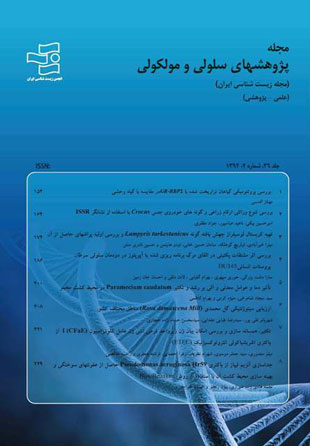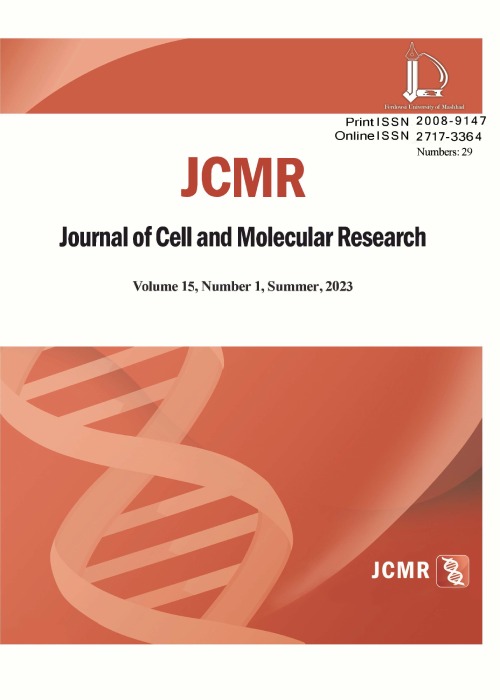فهرست مطالب

Journal of Cell and Molecular Research
Volume:5 Issue: 2, Winter and Spring 2013
- تاریخ انتشار: 1392/08/20
- تعداد عناوین: 9
-
-
Page 47Cancer remains a major cause of death worldwide. Huge research and identification of several markers have resulted in better understanding of its mechanism. Researches focusing on cancer stem cells and their role in metastasis will help the scientific community to propose the therapeutic approaches for treatment of this monstrous disease. Interest of governmental agencies and inter-communications of molecular biologists with clinicians can boost the new ideas in identification and characterizations of cancer stem cells. It will also help to elucidate their roles in tumor progression and hopefully would result in better ways to reduce the mortality related to cancerKeywords: Cancer stem cells, metastasis, abnormal growth
-
Pages 48-53Nowadays, production of recombinant proteins in eukaryotes is gaining good deal of attention. Transgenic chicken as a eukaryotic system has a high potential for producing recombinant proteins. Post-translational changes, especially glycosylation, are characteristic of the eukaryotic proteins. In practice we need to choose a proper expressing host when considering over-expression of a recombinant protein. Chickens are among the well-considered candidates for such application. Production of transgenic chickens could be achieved in different ways, including application of primordial germ cells. Primordial germ cells are progenitor of sperm and ovum. These cells are round, with a big nucleus and a cytoplasm with lipid and glycogen particles. The first step for having transgenic chickens is isolation and culture of the primordial gem cells. In the present study, these cells were isolated by centrifugation method in presence of ficoll and using magnetic cell sorting, and were cultured in optimal culture medium. These cells were finally characterized with defined methods, like Periodic acid-schiff staining, alkaline phosphates activity assessment, and antibody staining.Keywords: primordial germ cells, transgenic chicken, recombinant proteins
-
Pages 54-59The prevalence of type 2 diabetes mellitus (T2DM) is rising dramatically in the Middle East, especially in the Islamic Republic of Iran, but the genetic basis of type 2 diabetes in Iran is poorly understood. Polymorphisms of hepatocyte nuclear factor-1α (HNF-1α) and glucagon-like peptide-1 receptor (GLP-1R) genes showed association with type 2 diabetes in several ethnic groups. In this study, we evaluated whether these markers confer susceptibility to T2DM in a diabetic population living in Mashhad (northeast of Iran). Genotyping of Ala98Val (HNF-1α) and Thr149Met (GLP-1R) was done by the restriction fragment length polymorphism-PCR (RFLP-PCR) method in the following groups: 1) early-onset diabetes (age at onset ≤ 35 years); 2) late-onset diabetes (age at onset > 35 years); and 3) control. Our results showed that CT (Ala/Val) genotype of HNF-1α was higher in the early-onset type 2 diabetic group compared to the controls but difference was not significant. We did not find the GLP-1R Thr149Met mutation in all participants. The prevalence of the HNF-1α (Ala98Val) and (GLP-1R) Thr149Met mutations has not been previously reported in Iranian participants. We conclude that these mutations are not a common cause of T2DM in our studied population.Keywords: Type 2 diabetes_Hepatocyte nuclear factor_1α Glucagon_like peptide_1 receptor_Polymorphism
-
Pages 60-64Agrobacterium tumefaciens is capable of gene transfer to both plant and non-plant organisms. Indeed, upon infection of eukaryotic cells, Agrobacterium tumefaciens transfers a piece of its tumor inducing (Ti)-plasmid, called T-DNA, to the host cell nucleus, which subsequently integrates into the host genome. The VirD2 virulence protein which has relaxase endonuclease activities covalently binds to the 5''end of T-DNA and facilitates its transfer, nuclear localization and integration into the host genome in collaboration with the interacting proteins of the host cell. The VirD2 is essential for Agrobacterium–mediated transformation of both plants and non-plant cells. Here, using yeast Green Flourescent Protein (yGFP) technology, we studied the subcellular localization of VirD2, expressed in the model eukaryote Saccharomyces cerevisiae. Fluorescence microscopy showed that an N-terminal yGFP fusion of VirD2 (i.e. 5'' GFP-VirD2 3''), was located in the nucleus of yeast. With C-terminal fusions of VirD2 to yGFP (i.e. 5'' VirD2-GFP 3''), no particular subcellular concentration of fluorescence was seen. This further confirms nuclear localization of VirD2 in eukaryotic cells and more importantly highlights the role of Nuclear Localization Signal sequences (NLS) of the C-terminal of VirD2 in this phenomenon.Keywords: VirD2, Nuclear delivery, GFP, Agrobacterium, Saccharomyces cerevisiae
-
Pages 65-74Shigella and Escherichia belong to the Enterobacteriaceae family which are the cause for most of the diarrheal cases in the world. Shigella can cause bacterial dysenteries and shigellosis. One of the most effective proteins for pathogenesis is invasion plasmid antigen C (IpaC). Other bacteria like Enterotoxogenic (ETEC), Enterohemorrhagic (EHEC), and E.coli can also cause diarrhea and produce intestinal disorders. Colonization factor antigen I (CFA/I), a critical virulence protein for these infections, has two subunits i.e. CfaB and CfaE. EHEC Attachment of bacteria is the main step of infection with intimin playing the key role in this function. This study was designed to elicit protection against the majority of diarrheal pathogens via development of polyvalent vaccine against Shigella, ETEC and EHEC. In silico techniques are as best tools to design new vaccines. For this purpose the immunogenic epitopes of CfaB, IpaC and Intimin were identified through bioinformatic tools and were then selected as major antigens to construct a chimeric protein (CII). The humoral and cellular immunities were analyzed bioinformatically. Prediction of allergens and mapping of IgE epitopes were carried out. The bioinformatic analysis showed each domain was folded separately in fusion structure. CII had many T and B cell epitopes in both linear and three-dimensional structures. This prediction of the chimeric construct had the potential to induce CD4+ and CD8+ immune responses against these pathogens. In addition CII could be accessible to surveillance by the immune system in mouse and human. In conclusion, in silico analysis showed that this chimeric protein can be used as a vaccine against Shigella, ETEC and EHEC simultaneously.Keywords: Intimin, CfaB, IpaC, Recombinant vaccine, Chimeric protein
-
Pages 75-80The purpose of this study was to investigate the polymorphism of K-casein (K-CN), β-Lactoglobulin (B-LG) and leptin (LP) genes in Iranian Holstein cattle by polymerase chain reaction-restriction fragment length polymorphism (PCR-RFLP) technique. DNA was extracted from blood samples of 139 cows using a modified phenol chloroform method. Association between K-CN, B-LG and LP genes’ polymorphism with milk production traits were investigated using mixed procedure of SAS software. The frequencies of AA, AB and BB genotypes for K-CN (0.72, 0.18 and 0.10), B-LG (0.43, 0.28 and 0.29) and LP (0.24, 0.63 and 0.13) were also calculated. Statistical results revealed a significant association between AA and BB genotypes of the K-CN gene with milk production and milk protein percentage, respectively. Also, BB genotype of the B-LG gene and AA genotype of the LP gene showed a significant association with protein percentage and milk production (PKeywords: Holstein cattle, K, casein, β, Lactoglobulin, leptin gene, PCR, RFLP, milk production traits
-
Pages 81-86The effect of sub culturing frequencies and different cytokinins (benzyl amino purine (BAP), 2-isopentenyl adenine (2ip) on genetic stability of micropropagated shoots from olive plant were investigated by using physiological traits and Random Amplified Polymorphic DNA (RAPD) markers. Axillary buds of the olive (cv. Dezful) plants were cultured and subcultured in DKW medium, supplemented with BAP (4 mgl-1) or 2-ip (4 mgl-1). In different hormone media and subcultures there were not significant differences in shoot proliferation rate. To amplify DNA, 18 arbitrary decamer primers were screened, out of which 16 primers generated clear and reproducible bands. All RAPD profiles from the micropropagated plants were monomorphic. The treatments included four successive subcultures in two hormone treatments (2ip or BAP) (4 mgl-1) The 16 primers produced a total of 213 (an average of 13.31 band per primer) scorable bands. The dendrogram constructed on the basis of jaccard’s similarity matrix, followed by UPGMA based clustering analysis showed that micropropagated plants were genetically stable and similar to the mother plant.Keywords: Micropropagation, genetic stability, Olea europaea L., RAPD
-
Pages 87-91Skin grafting always has been considered a challenging task for the researchers and tissue engineers from its first introduction in 1871 by Reverdin. Skin substitutes, composed of degradable synthetic or biological components, are being considered as emergency replacements/grafts to the damaged skin. A number of technical developments in this filed have led to development of several skin substitutes, such as Biobrane®, Integra®, OrCel®, Suprathel® etc which are available for clinical utilization. From these, some characteristics, including infection resistance, water loss prevention, long shelf life, easy to store are set as criteria for assessment of the products. Post grafting problems associated with available skin substitutes questioned their reliability and reject them as an ideal skin substitute. Innovative tissue engineering approaches based on biological scaffolds and clinical grade stem cells could be an attractive alternative for available skin substitutes.Keywords: Tissue engineering, allografts, xenografts, epidermis, keratinocyte cultures, Skin Substitutes
-
Pages 92-93Preconditioning (PC), is an approach to improve therapeutic potential of stem cells against ischemic environment. PC has several advantages over other therapeutic techniques as this results in increase of transplanted stem cells recruitment, retention, survival and subsequently the induction of a more supportive environment within the damaged tissue via secretion of angiogenic factors. Special attention is needed to recognize new materials, compounds, and conditions to assess the feasibility of PC for being applied in clinics to treat the ischemic diseases.Keywords: stem cell preconditioning, cardiovascular diseases, ischemic heart diseases, progenitor cells


